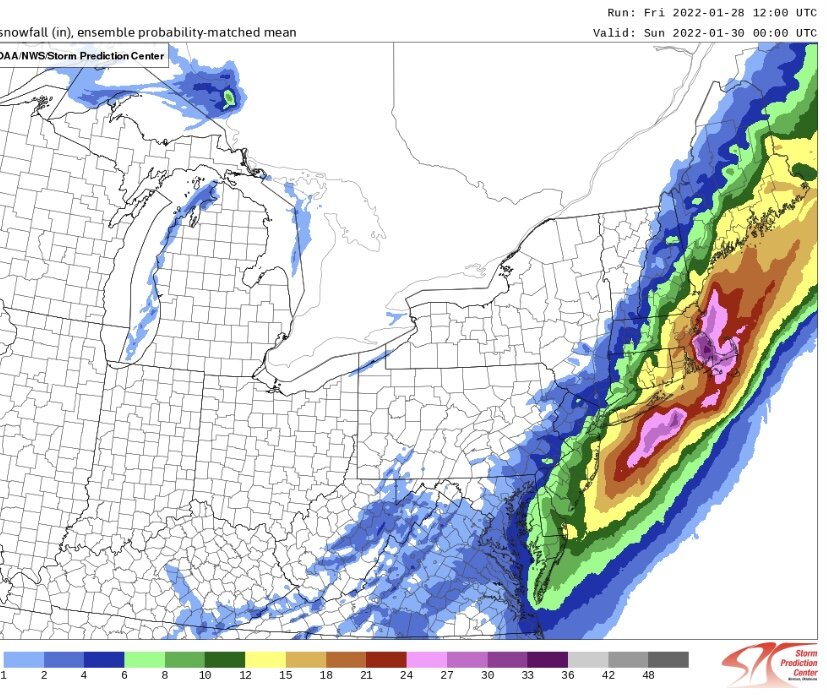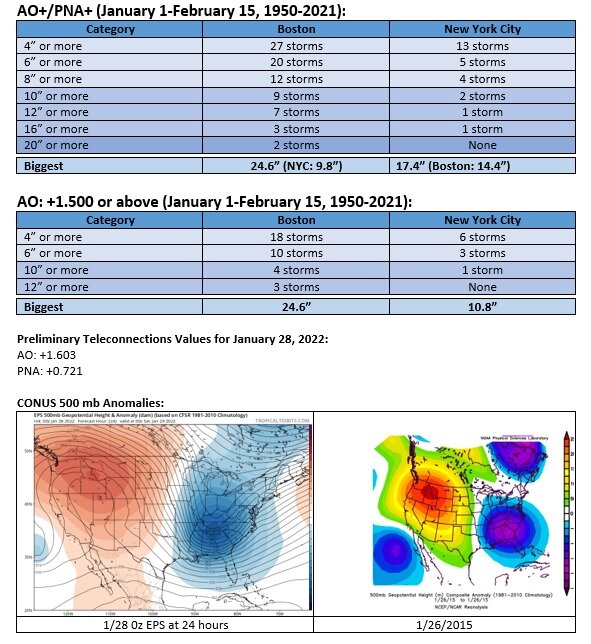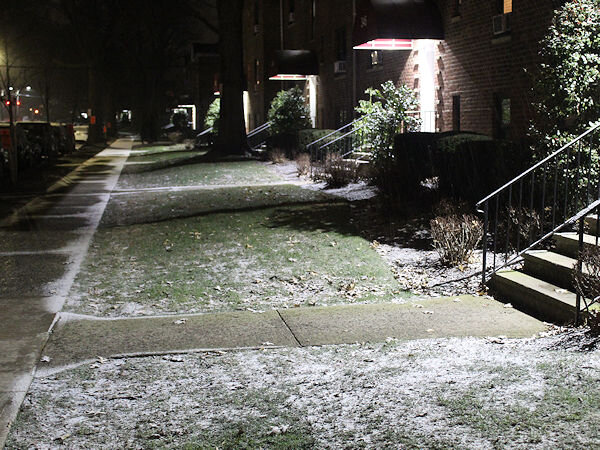-
Posts
22,875 -
Joined
Content Type
Profiles
Blogs
Forums
American Weather
Media Demo
Store
Gallery
Everything posted by donsutherland1
-

January 28/29 Blizzard Observations/Discussion/Nowcasting
donsutherland1 replied to Northof78's topic in New York City Metro
Just after 10 pm: -
A negative AO often translates into a wavier, more meridional jet stream. This allows storms to track more northward rather than eastward during zonal situations. The upcoming storm has some upper air similarities to the January 2015 storm.
-
A rapidly intensifying storm will move northward off the Atlantic coast bringing blizzard conditions to parts of Long Island and eastern New England. During the height of the storm, winds could gust past 60 mph in that region with temperatures falling into the teens. Visibilities will decrease to 1/8 mile or less. Moderate to heavy snow will reach Newark and New York City for a time, but the heaviest amounts will fall east of those areas. Snowfall estimates: Boston: 16"-24" Bridgeport: 7"-14" Islip: 14"-20" New York City: 6"-12" Newark: 5"-10" Philadelphia: 4"-8" Poughkeepsie: 2"-4" During the January 15-February 15, 1950-2021 period, 37% of Boston's 10" or greater snowstorms have occurred during an AO+/PNA+ pattern. In contrast, just 12% of New York City's and 10% of Philadelphia's 10" or greater snowstorms have occurred with such a pattern. Not surprisingly, for New York City and Newark to reach 10" or more, one will need the storm to phase somewhat farther to the west than is currently modeled. The ENSO Region 1+2 anomaly was -0.5°C and the Region 3.4 anomaly was -0.8°C for the week centered around January 19. For the past six weeks, the ENSO Region 1+2 anomaly has averaged -1.05°C and the ENSO Region 3.4 anomaly has averaged -0.98°C. La Niña conditions will likely persist through meteorological winter. The SOI was +23.65 today. The preliminary Arctic Oscillation (AO) was +1.603. On January 26 the MJO was in Phase 8 at an amplitude of 0.847 (RMM). The January 25-adjusted amplitude was 0.910 (RMM). Based on sensitivity analysis applied to the latest guidance, there is an implied near 100% probability that New York City will have a colder than normal January (1991-2020 normal). January will likely finish with a mean temperature near 30.2° (3.5° below normal).
-
-
I agree. FWIW, below are Suffolk County's amounts from that storm: ...SUFFOLK COUNTY... ORIENT 30.0 807 PM 1/27 TRAINED SPOTTER SOUTHAMPTON 29.0 615 PM 1/27 PUBLIC MATTITUCK 26.9 404 PM 1/27 TRAINED SPOTTER MEDFORD 25.6 100 PM 1/27 PUBLIC ISLIP AIRPORT 24.9 100 PM 1/27 FAA CONTRACT OBSERVER NORTH PATCHOGUE 24.1 1235 PM 1/27 PUBLIC WEST BABYLON 24.0 600 PM 1/27 PUBLIC OAKDALE 23.5 120 PM 1/27 PUBLIC MILLER PLACE 22.0 130 PM 1/27 PUBLIC FLANDERS 22.0 204 PM 1/27 TRAINED SPOTTER PORT JEFFERSON STATI 22.0 600 PM 1/27 PUBLIC LINDENHURST 21.6 530 PM 1/27 TRAINED SPOTTER FARMINGVILLE 21.5 330 PM 1/27 TRAINED SPOTTER HOLBROOK 21.5 100 PM 1/27 PUBLIC EAST NORTHPORT 21.0 715 PM 1/27 PUBLIC SHOREHAM 21.0 413 PM 1/27 PUBLIC COMMACK 20.0 1030 AM 1/27 PUBLIC DEER PARK 20.0 1230 PM 1/27 PUBLIC SMITHTOWN 20.0 1240 PM 1/27 PUBLIC UPTON 17.1 100 PM 1/27 NWS OFFICE BAY SHORE 16.5 1110 AM 1/27 TRAINED SPOTTER TERRYVILLE 16.5 1202 PM 1/27 PUBLIC ST. JAMES 16.0 1100 AM 1/27 PUBLIC YAPHANK 15.7 220 PM 1/27 PUBLIC LAKE RONKONKOMA 14.0 1120 AM 1/27 TRAINED SPOTTER OLD FIELD 9.2 212 PM 1/27 TRAINED SPOTTER
-
While waiting for additional model runs, some info. regarding snowstorms with an AO+/PNA+ pattern. The 500 mb pattern over the U.S. is similar to that of January 26, 2015 leading up to a storm that brought 24.6" snow to Boston, 10.7” to JFK, 11.0”, to LGA and 9.8" to NYC. There were widespread 12”-20” amounts in Suffolk County. The synoptic evolution and details will drive the outcomes for the upcoming storm.
-

January 28/29 Blizzard Observations/Discussion/Nowcasting
donsutherland1 replied to Northof78's topic in New York City Metro
Light snow in the Bronx. Surfaces are dusted. -
Morning thoughts… It will be mostly cloudy with some snow flurries and snow showers. High temperatures will likely reach the lower and middle 30s in most of the region. Likely high temperatures around the region include: New York City (Central Park): 33° Newark: 33° Philadelphia: 36° A rapidly intensifying storm will bring heavy snow with blizzard conditions to parts of the region late tonight and tomorrow. The worst of the storm will occur on Long Island and in eastern New England where blizzard conditions are likely to occur. The 6z NAM likely illustrates the top-end case that is possible from the storm, not the most likely scenario right now. The situation remains complex and modest adjustments can still lead to large changes in snowfall amounts. Snowfall estimates: Boston: 16”-24” Bridgeport: 7”-14” Islip: 14”-20” New York City: 6”-12” Newark: 5”-10” Philadelphia: 4”-8” Poughkeepsie: 2”-4” Normals: New York City: 30-Year: 39.5°; 15-Year: 39.8° Newark: 30-Year: 40.0°; 15-Year: 40.5° Philadelphia: 30-Year: 41.3°; 15-Year: 41.6°
-
You have my fullest condolences. I’m very sorry to learn of your father’s passing.
-
Thanks, North and West.
-
Clouds will increase tomorrow as a bomb cyclone takes shape off the southeastern U.S. That storm will move northward and bring blizzard conditions to parts of Long Island and eastern New England. During the height of the storm, winds could gust past 60 mph in that region with temperatures falling into the teens. Visibilities will decrease to 1/8 mile or less. Moderate to heavy snow will reach Newark and New York City for at least a time, but the heaviest amounts will fall east of those areas. Snowfall estimates: Boston: 12"-24" Bridgeport: 6"-12" Islip: 8"-16" New York City: 4"-8" Newark: 4"-8" Philadelphia: 3"-6" Poughkeepsie: 2"-4" During the January 15-February 15, 1950-2021 period, 37% of Boston's 10" or greater snowstorms have occurred during an AO+/PNA+ pattern. In contrast, just 12% of New York City's and 10% of Philadelphia's 10" or greater snowstorms have occurred with such a pattern. Not surprisingly, for New York City and Newark to reach 10" or more, one will need the storm to phase somewhat farther to the west than is currently modeled. The ENSO Region 1+2 anomaly was -0.5°C and the Region 3.4 anomaly was -0.8°C for the week centered around January 19. For the past six weeks, the ENSO Region 1+2 anomaly has averaged -1.05°C and the ENSO Region 3.4 anomaly has averaged -0.98°C. La Niña conditions will likely persist through meteorological winter. The SOI was +13.67 today. The preliminary Arctic Oscillation (AO) was +1.704. On January 25 the MJO was in Phase 8 at an amplitude of 0.910 (RMM). The January 24-adjusted amplitude was 0.953 (RMM). Based on sensitivity analysis applied to the latest guidance, there is an implied near 100% probability that New York City will have a colder than normal January (1991-2020 normal). January will likely finish with a mean temperature near 30.3° (3.4° below normal).
-
This is correct. I will try to post the data later.
-
Morning thoughts... Today will mostly sunny but cold. Temperatures will likely reach the lower and middle 30s across much of the region. Likely high temperatures include: New York City (Central Park): 33° Newark: 33° Philadelphia: 35° Clouds will increase tomorrow and snow will arrive. Initial snowfall estimates: Boston: 12"-18" Bridgeport: 6"-12" Islip: 7"-14" New York City: 4"-8" Newark: 4"-8" Philadelphia: 3"-6" Poughkeepsie: 2"-4"
-
Better than 18z.
-
The cold will begin to slowly ease tomorrow. However, the risk of a potentially significant storm in parts of the East continues to increase. Already, Boston, Islip, and Providence appear likely to see 10" or more of snow, but the probability of such an outcome has decreased. Guidance has continued to push the event farther to the east throughout the day. Snowfall amounts for New York City and Newark are unusually uncertain, as phasing situations are complex and small details can make for large changes in outcomes. There still remains some potential for a 4"-8" snowfall in both cities. The PNA is positive and is likely to remain positive through at least January 30th. A positive PNA is associated with more frequent snowfalls in the Middle Atlantic region. However, big snowfalls typically occur when the AO is negative, especially in such cities as Washington and Philadelphia. Prospects of a negative AO have faded. During the January 15-February 15, 1950-2021 period, 37% of Boston's 10" or greater snowstorms have occurred during an AO+/PNA+ pattern. In contrast, just 12% of New York City's and 10% of Philadelphia's 10" or greater snowstorms have occurred with such a pattern. Hence, confidence in a 10" or more snowfall in Boston and eastern New England remains solid. Synoptic details, which remain fluid, will be crucial to the outcomes from Philadelphia to New York City. In the wake of the storm, a pattern change toward persistent milder conditions will likely begin to evolve. The ENSO Region 1+2 anomaly was -0.5°C and the Region 3.4 anomaly was -0.8°C for the week centered around January 19. For the past six weeks, the ENSO Region 1+2 anomaly has averaged -1.05°C and the ENSO Region 3.4 anomaly has averaged -0.98°C. La Niña conditions will likely persist through meteorological winter. The SOI was +16.73 today. The preliminary Arctic Oscillation (AO) was +2.422. On January 24 the MJO was in Phase 7 at an amplitude of 0.954 (RMM). The January 23-adjusted amplitude was 1.097 (RMM). Based on sensitivity analysis applied to the latest guidance, there is an implied near 100% probability that New York City will have a colder than normal January (1991-2020 normal). January will likely finish with a mean temperature near 30.4° (3.3° below normal).
-
The importance of blocking from NYC and southward cannot be overstated. An AO-/PNA+ was present for the following % of 10” or greater snowstorms during the January 15-February 15 period (1950-2021): Boston: 42% (n=19) New York City: 71% (n=17) Philadelphia: 90% (n=10) 2 or more of those cities: 81% (n=16) All 3 of those cities: 86% (n=7).
-
Morning thoughts... Today will mostly sunny but cold. Temperatures will likely reach the upper 20s and lower 30s across much of the region. Likely high temperatures include: New York City (Central Park): 28° Newark: 30° Philadelphia: 31° A significant storm could impact the region this weekend. At present, it seems that New York City and Newark are in line for a 4"-8" snowfall, while cities such as Boston, Islip, and Providence will likely see 10" or more. There remains considerable uncertainty, which could result in large changes in snowfall amounts.
-
Today's warmth will be short-lived. A strong cold shot will bring much colder weather for tomorrow. Afterward, the cold will likely begin ease, but the risk of a potentially significant storm in parts of the East continues to increase. Already, Boston, Islip, and Providence appear likely to see 10" or more of snow. A pattern change toward persistent milder conditions could begin to evolve during the first week of February. The PNA is positive and is likely to remain positive through at least January 30th. A positive PNA is associated with more frequent snowfalls in the Middle Atlantic region. However, big snowfalls typically occur when the AO is negative, especially in such cities as Washington and Philadelphia. Some individual ensemble members hint at the AO's going negative for a time in the closing days of the month. The ENSO Region 1+2 anomaly was -0.5°C and the Region 3.4 anomaly was -0.8°C for the week centered around January 19. For the past six weeks, the ENSO Region 1+2 anomaly has averaged -1.05°C and the ENSO Region 3.4 anomaly has averaged -0.98°C. La Niña conditions will likely persist through meteorological winter. The SOI was +16.92 today. The preliminary Arctic Oscillation (AO) was +1.843. On January 22 the MJO was in Phase 7 at an amplitude of 1.095 (RMM). The January 21-adjusted amplitude was 0.891 (RMM). Based on sensitivity analysis applied to the latest guidance, there is an implied near 100% probability that New York City will have a colder than normal January (1991-2020 normal). January will likely finish with a mean temperature near 30.4° (3.3° below normal).
-
It looks like the NAO will be around +0.500. During 1950-99, the January NAO was negative on 64.7% days when the AO was negative. Since 2000, that percentage has fallen to 53.0%.
-
Morning thoughts... Today will be variably cloudy and milder. Temperatures will likely reach the lower 40s across much of the region. Likely high temperatures include: New York City (Central Park): 41° Newark: 41° Philadelphia: 44° Tomorrow will be much colder. A significant storm could impact the region this weekend. Normals: New York City: 30-Year: 39.3°; 15-Year: 39.7° Newark: 30-Year: 39.8°; 15-Year: 40.4° Philadelphia: 30-Year: 41.1°; 15-Year: 41.5°
-
The NAO stays positive.
-
Tomorrow will be briefly milder. Many areas will see the thermometer rise into the lower 40s. However, the warmth will be short-lived. A strong cold shot will bring much colder weather for Wednesday. Parts of the Northeast have the potential to experience their coldest temperatures of the winter. Afterward, the cold will likely begin ease, but the risk of a potentially significant storm in parts of the East could increase. A pattern change toward persistent milder conditions could begin to evolve during the first week of February. The extended range of the EPS already shows the start of a warming trend in the closing days of January, so the timing remains somewhat uncertain. Such large-scale pattern changes have sometimes been preceded by or coincided with storms. The PNA is positive and is likely to remain positive through at least January 27th. A positive PNA is associated with more frequent snowfalls in the Middle Atlantic region. However, big snowfalls typically occur when the AO is negative, especially in such cities as Washington and Philadelphia. Some individual ensemble members hint at the AO's going negative for a time in the closing days of the month. The ENSO Region 1+2 anomaly was -0.5°C and the Region 3.4 anomaly was -0.8°C for the week centered around January 19. For the past six weeks, the ENSO Region 1+2 anomaly has averaged -1.05°C and the ENSO Region 3.4 anomaly has averaged -0.98°C. La Niña conditions will likely persist through meteorological winter. The SOI was +13.15 today. The preliminary Arctic Oscillation (AO) was +0.947. On January 21 the MJO was in Phase 7 at an amplitude of 0.888 (RMM). The January 20-adjusted amplitude was 0.757 (RMM). Based on sensitivity analysis applied to the latest guidance, there is an implied near 100% probability that New York City will have a colder than normal January (1991-2020 normal). January will likely finish with a mean temperature near 30.4° (3.3° below normal).
-
Morning thoughts… It will be partly sunny and cool today. High temperatures will likely reach the lower and middle 30s in most of the region. Likely high temperatures around the region include: New York City (Central Park): 33° Newark: 34° Philadelphia: 36° Normals: New York City: 30-Year: 39.2°; 15-Year: 39.7° Newark: 30-Year: 39.7°; 15-Year: 40.4° Philadelphia: 30-Year: 41.0°; 15-Year: 41.5° Tomorrow will be briefly milder before another very cold air mass overspreads the region.
-
It’s pretty much there, except statistically.






